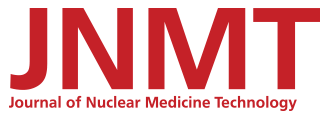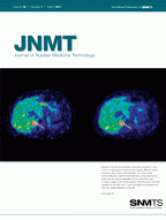
Kathy Hunt, MS, CNMT
Over the past decade, the scope of nuclear medicine technology has expanded, with remarkable advances in nuclear cardiology instrumentation and processing, PET, SPECT, and hybrid imaging technology. This rapid evolution has been accompanied by a demanding health-care environment that has challenged the profession to produce entry-level nuclear medicine technologists (NMTs) with critical thinking skills and cutting-edge technologic skills, and with a solid foundation in general-studies course work, including the basic sciences.
Currently, several pathways exist for NMTs to gain the necessary education and skills. Nuclear medicine technology programs may be offered at the certificate, associate, or baccalaureate level. Although entry into some certificate programs requires a bachelor's or associate's degree, others accept high school graduates, making it extremely difficult to produce a graduate with the desired knowledge and skills during such a limited time frame. Also, the total number of credit hours needed to earn a degree in nuclear medicine technology at the associate level continues to increase to meet the curricular requirements. This number is quickly approaching that needed to earn a bachelor's degree.
At the 2005 SNM annual meeting, a recommendation for a minimum educational standard for NMTs entering the field was presented by the entry-level task force (part of the educator's committee) to the SNMTS executive board. After much discussion and debate, the executive board recognized the need for an enhanced and standardized curriculum. The board formally recommended that a bachelor's degree become the standard education for all entry-level NMTs by 2015. This recommendation was based not on historical dissatisfaction with previous entry-level NMT program graduates but on an effort to lead our profession to a new level and address changes in the field. The main impetus for the proposal was that the NMT scope of practice is continually expanding and a curriculum with standardized prerequisites is needed to address the base knowledge required of all NMTs.
Since this proposal in 2005, much has been done by SNMTS. The entry-level task force began to formulate a plan for expanding NMT education requirements. The first step was to hold an educational summit of SNMTS board members and liaison representatives from 24 organizations to discuss the proposal and inform stakeholders of the process moving forward. In 2006, another educational summit was held for program directors to discuss the process and challenges ahead and determine the next steps. Thirty program directors from across the country—representing certificate, associate, and baccalaureate levels—attended.
To establish the curriculum revisions needed to meet changes in practice, such as occurred with the introduction of PET/CT, the 2006–2007 transition task force (previously the entry-level task force) reviewed the existing curriculum as documented by the SNMTS Curriculum Guide, 3rd edition. Many resources were used, and several factors were taken into consideration to determine the content needed to practice nuclear medicine by 2015. Incorporated into the curriculum was such additional content as hybrid imaging, including CT physics, instrumentation, acquisition, and processing; pharmacology, including adjunct medications and contrast media; and expanded patient care skills, including monitoring and assessment of side effects and adverse reactions to medications. In the next year, the transition task force, comprising nuclear medicine technology educators, added this content to the SNMTS Curriculum Guide and decreased or eliminated other areas, to produce the 4th edition, which was finalized in 2008. This edition included the required core courses and optional prerequisites along with the nuclear medicine technology professional course work.
To assist programs in incorporating the curriculum and in meeting the recommendation for a bachelor's degree, 2 working groups were formed in 2009 under the SNMTS transition task force of the educator's committee: an advisory board and a resource-manual group. Educators with experience in transitioning to a bachelor's degree program made up the advisory board. Three schools representing the various models of nuclear medicine education were selected to participate in a pilot program: Florida Hospital College of Health Sciences, Southeast Technical Institute in South Dakota, and Northwestern Memorial Hospital in Illinois. The advisory board members assisted their assigned schools in developing a model to offer a bachelor’s degree or meet the curriculum standards of a postbaccalaureate program. The resource-manual group developed an online manual for programs interested in determining what model and resources they might need to transition their program to the baccalaureate level. This group compiled information such as a gap analysis, sample curricula, and transitioning models, including time-lines, for this resource.
In 2010, the 3 pilot program schools began their transition to the bachelor's degree. Each school chose a different model for implementation; however, all have reported positive experiences in making the transition. Representatives from the schools will present their experiences at the 2011 SNM annual meeting in June during an open session. Three additional schools applied and have been chosen for 2011 to begin the transition to a bachelor's degree program, and the SNMTS advisory board will work with each to help navigate the process.
The process for requiring a bachelor's degree for NMTs is a complex one. It has taken SNMTS several years to put into place all the pieces needed for a successful initiative. We still, however, face challenges. Many schools cannot currently transition to a bachelor's degree program because of legislative obstacles. Some schools remain hesitant to convert to the baccalaureate level until mandated by accrediting or credentialing bodies. SNMTS will continue to provide resources to assist programs with the transition and ensure that the bachelor's degree initiative keeps moving forward and that this degree becomes the standard for our profession.
Nuclear medicine technology is an ever-changing profession and has become an even more demanding field than when we started this initiative in 2005. As forward thinkers, the leadership of SNMTS proposed the bachelor's degree as the entry-level standard because of the expanding knowledge base required to incorporate emerging technologies into the practice of nuclear medicine. The bachelor's degree initiative will equip technologists with the knowledge base and critical thinking skills needed to succeed in a changing workplace and provide high-quality care to patients. SNMTS has come a long way in promoting this initiative, and we are starting to see some progress as models are developed and programs make the transition. We are looking forward to even more success in the future.







